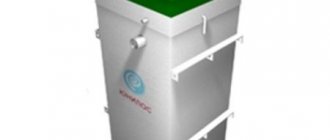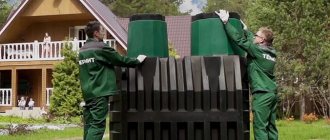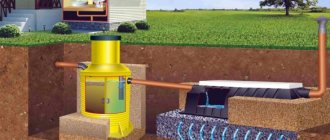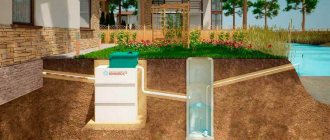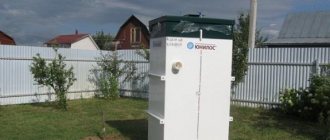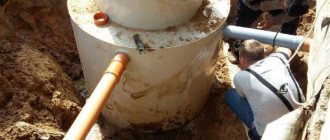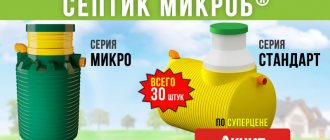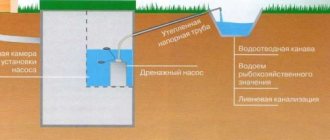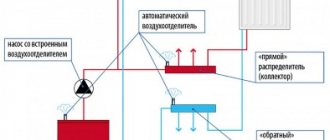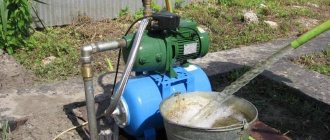The Triton septic tank is a durable plastic storage tank. According to the principle of operation, the Triton septic tank resembles a classic cesspool. The tank consists of three chambers, where in each the process of decomposition of biological material takes place by settling solid particles to the bottom. Purified water enters the filtration platform.
The storage septic tank operates autonomously. The service life of the tank is up to 50 years. The Triton septic tank model range is represented by tanks of various volumes: from 2 to 40 m3. The degree of wastewater treatment is no more than 60%. When using additional equipment - an infiltrator or an aeration field, the purification level reaches 90%.
The Triton storage septic tank is designed for collecting waste and decomposition. Processing occurs with the help of anaerobic bacteria. During the life of microorganisms in the septic tank, carbon dioxide and hydrogen sulfide are released. Gases are removed from the septic tank through ventilation. The accumulated sediment must be periodically pumped out using a sewer truck. The frequency of pumping depends on the number of people living in the house.
Advantages and disadvantages of the Triton septic tank
This is what a Triton-Mini septic tank installed in the ground looks like.
There are quite a lot of systems available in the market that carry out local wastewater treatment and they all have their advantages and disadvantages. When choosing a treatment plant, it is necessary to take into account what tasks it faces and where it should be located.
For example, if you are choosing a septic tank for your dacha , then it is better for you to choose energy-independent systems, such as Triton, and if you are organizing a treatment facility for a private house in the city with permanent residence, then it is most likely reasonable for you to look for more powerful energy-dependent systems, such such as Topas , Tver , Yunilos Astra , Evost Bio .
Advantages:
- Durability, strength and high reliability are achieved through the manufacture of Triton from polypropylene. The service life reaches 50 years. If we talk about such home-made structures, then we can consider a septic tank made of Eurocubes.
- High productivity and efficiency - the tanks can receive a sufficient volume of wastewater for subsequent sedimentation and post-treatment.
- The septic tank is pumped out quite rarely - about once a year, and when using anaerobic bacteria, this period can be increased up to 5-8 years.
- Saving money - installation is very simple and does not require specific tools, so you can save on it.
- Energy independence - for the septic tank to operate, it does not need to be connected to the power supply, so it can be installed during periodic residence and in places where there are frequent power outages.
However, some advantages on the one hand may be disadvantages on the other:
- Non-volatile septic tanks (including Tank and Termite ) do not have a very high degree of filtration - about 65-70%; in order for the degree of filtration to be about 98%, like that of energy-dependent treatment facilities, it is necessary to additionally equip soil post-treatment of wastewater using an infiltrator or filtration fields. This in turn requires additional space.
Selection criteria and overview of models
When choosing a Triton septic tank, whether for a summer house or a country house, you should focus on the following factors:
- depth of groundwater;
- number of residents;
- time of residence (seasonal, permanent);
- number of drains;
- soil type;
- climate.
It is recommended to determine the volume of the treatment plant based on how much wastewater the room for which it is intended discharges in 2-2.5 days.
Treatment facilities of this series are suitable for areas with sandy, moisture-unsaturated soil and low groundwater levels.
The manufacturer guarantees efficient operation of the system down to -300 C.
Model range of septic tanks for summer cottages Triton
The variety of Triton septic tank models allows you to choose the best option for both a small family and a large company.
For 1-2 people who live in the house only during the summer season, it will be enough to install the Triton Micro model.
This model is the smallest of the septic tanks of this brand. The device can be used for a bathhouse, guest house, storm sewer. Its tank is capable of storing 450 liters of water. Productivity per day – 150 l. The structure weighs only 40 kg and can be transported to its destination by car.
The Triton Mini septic tank is designed for a family of 1-3 people. Most often installed in summer houses and dachas. Capacity volume – 750 l. Productivity per day – 250 l. The weight of the structure is 85 kg.
Effluents that have passed through the Triton Mini system are purified by 55-65%. Therefore, both the Triton Micro and Triton Mini models must work in conjunction with an infiltrator that is capable of cleaning wastewater up to 90%.
Model range of local treatment plant Triton
The model range of this manufacturer allows you to choose both economical solutions for a small volume of daily wastewater, and for permanent residence and, accordingly, large cleaning needs. From single-chamber to triple-chamber systems, you can choose a solution to suit your needs.
Triton includes the following model range:
- The Triton-N septic tank is a single-chamber container with a volume of 1 to 4 m³ - in fact, this is a dacha solution.
- The Triton-Microbe Mini septic tank is a two-chamber design, suitable for two permanent residents.
- Triton-ED is also a two-chamber type, with a volume of 1.8 m³, 2.0 m³ and 3.5 m³, suitable for 1-3 permanent residents.
- Triton-T , a three-chamber design, with a volume of up to 30 m³, is suitable for 2-3 permanent residents.
Before you make your final choice, you need to calculate your daily wastewater output, for this you can use our calculator . On average, according to SNiP standards, one person receives 150-200 liters of wastewater. In addition to the septic tank, you can select drainage wells to collect purified water. In addition, it is necessary to study the features of the site for the presence of high groundwater levels , and if they exist, the possibility of installing a septic tank.
Let's look at the main models.
Septic tank Triton-N
Septic tank Triton-N
This septic tank, marked “N,” is a single storage chamber in which there are virtually no basic septic processes. In fact, this is a more advanced and environmentally friendly drainage pit and works only to collect and accumulate wastewater. As it is filled, it is cleaned using a sewer truck.
This solution is suitable for very economical drainage of wastewater, for example, in a summer cottage with infrequent visits. The volume of the containers can be from 1 to 5 m³, weight from 74 to 263 kg, and the diameter will be from 1170 to 4720 mm, while the length will be the same - 1200 mm.
Nevertheless, there are drives of large volumes:
- Length from 3.6 to 13 meters.
- Diameter from 1.5 to 2 meters.
- Volume from 6 to 40 m³.
Such models will be able to serve larger buildings with 4 to 60 people living in them. Their surface is more durable due to the flat ends and corrugated ribbed outer part.
Septic tank Triton-Mini
Triton Microbe Mini The
“Mini” model is considered one of the most popular, because it is a very inexpensive solution for a small family of two permanent residents and an additional two or three who come, for example, on weekends. Great interest in it is also caused by its relatively inexpensive price - about 25 thousand for installation. This would be a good solution for installing a sewer system for a summer house, country house or bathhouse.
Structurally, the device consists of two interconnected two separate containers, which are connected by pipes to each other both at the top and at the bottom. This solution allows sludge to settle at the bottom in the common space of two chambers, while the settled water can flow between the compartments. Thanks to the manufacturing of the structure from HDPE (low-density polyethylene), this allows it to withstand low temperatures (down to -30 degrees) - the body does not crack or burst, and decent mechanical loads, as well as this material, can withstand aggressive environments.
As a rule, Triton-Mini is sold together with a soil purification system - infiltrator ; their combined use allows the degree of wastewater purification to be increased to approximately 98%, and without it the water is purified by only 65-70%. Such a structure allows you to increase the time of accumulation of sludge in the receiving chamber of the septic tank, which requires cleaning, and reduce the number of calls to the sewer truck and, accordingly, will lead to saving money. In addition, in the second chamber of the structure there is a biofilter with a floating load, which makes it possible to better filter the wastewater before feeding it into the infiltrator.
The popularity of this model is also due to the convenient height of the lid, which allows inspection and technical needs to be carried out without any problems; the design is lightweight and efficient (allows you to clean about 10 buckets or approximately 500 liters per day). Due to its low weight (about 70 kg), installation will not be a big problem - it can be done by one or two people without the use of specialized equipment within a few days.
Maintenance will not be a big problem; the septic tank is cleaned approximately once a year using a sewer machine. You can also clean the septic tank using a special fecal pump. And sludge in some cases can be used as fertilizer.
Triton-ED 1800
Triton-ED with an installed infiltrator for soil before cleaning
. This model is the newest of all similar modifications; its peculiarity is that the container of the structure is solid, and inside it is divided into two chambers. In the first chamber, primary settling occurs, settling of solid fractions and formation of sludge, and the settled water flows into the second chamber. Additional settling occurs in it and is then discharged either into the after-treatment system or into a storage tank.
Thanks to the installed upper overflow pipe, in case of critical filling, water will flow over, which will avoid overflowing and overloading of the compartments. The septic tank is designed for both private houses and cottages for 2-3 permanent residents.
Wastewater treatment in a septic tank is carried out anaerobically, using biobacteria , the system is energy independent. Please note that the degree of purification of this structure is about 60%, so it is necessary to use soil additional purification using an infiltrator or filtration fields. Thanks to them, the water will be purified almost 100%.
The body is made of polypropylene, which significantly increases the service life (up to 50 years), and it is cast, multi-layered and has no seams, which increases its strength. The septic tank can operate at low temperatures, but not exceeding -30 degrees. The treatment plant is pumped out once a year. In the case of winter preservation, up to 70% of the contents are pumped out of it, and in the spring a little water is added and new bacteria are added. The productivity is approximately 600 liters per day, which is already a good indicator and encourages you to choose such a solution.
Triton-T
Triton-T with a filtration well
Models of the T series (1 m³, 1.5 m³, 2 m³) have a different design from the above listed ED and MINI. The difference is that the septic tank is three-chamber, which allows you to increase its productivity and degree of purification. The body is made of high quality plastic.
To regularly check the filling and blockages, the structure is equipped with a technical well located above the septic tank, which has a sufficient diameter and height. Thanks to tightly pressed sewer hatches, the internal containers are protected from precipitation.
Wastewater purification is carried out anaerobically with a purification degree of about 90%, but for better purification, filtration fields or an infiltrator should be installed, thanks to which the purification degree will reach almost 100%. Thanks to the multi-chamber design, such a system can serve a larger number of users - from 2 to 60 people, depending on the volume of containers.
Another difference from previous models is that the design is highly durable, and this allows you to bury the septic tank to a depth of more than 1 meter for any soil composition. This is achieved by the fact that the body is manufactured using rotomolding and extrusion welding methods, thereby providing a service life of 50 to 70 years. In addition, it can be used at lower temperatures – down to – 40 degrees.
Dimensions of structures:
- T-1 (1000 liters) – wall thickness – 14 mm, diameter – 1200 mm, length – 1170 mm.
- T-1.5 (1500 liters) – diameter – 1200 mm, container length 1620 mm.
- T-2 (2000 liters) – diameter 1200 mm, length – 2021 mm.
The productivity of these models ranges from 500 to 700 liters per day, and depending on the volume of containers, they can organize life for 2-5 permanent residents.
How do septic tanks work?
Classic septic tanks - such as Triton - produce only partial wastewater treatment. The output water can only be conditionally called clean. The average degree of purification is 50-60%. During normal operation of the septic tank, it should be transparent and odorless, but it cannot be used without additional cleaning. It is not even suitable for technical needs. In order for it to be used in any way, it requires additional purification. Most often, clarified wastewater after a septic tank is discharged to filtering devices - a well, platform, ditch, or discharged into the ground through infiltrators, drainage tunnels.
An example of organizing complete water purification at high groundwater levels
How is wastewater cleaned in a septic tank?
The Triton septic tank is divided into two or three compartments, depending on the model. The first - the largest - storage device. Drainage from the house flows into it through the inlet pipe. In it, organic matter is fermented and gradually decomposed by bacteria that live in the waste. In this case, the solid components begin to decompose/disintegrate and settle to the bottom. Particles containing fats are also released. Since they are lighter than water, they rise to the surface, forming a film/crust there, which creates ideal conditions for the life of bacteria.
How does a septic tank work?
Thus, it turns out that in the middle there is more or less clean water. Therefore, it is in the middle part of the partition (a little closer to the top) that an overflow is made, through which relatively clean water flows into the next compartment. In it, the process continues - solid particles precipitate, fat-containing particles rise up. Even lighter water is poured into the third compartment, where the final clarification of the wastewater occurs. Next, the wastewater is sent for additional treatment, since the level of purification does not allow it to be used in any other way.
As in the case of a storage tank, a classic septic tank requires periodic pumping of accumulated sludge using a sewage disposal machine. It's all about the period of time that passes between procedures. For a storage tank you may need a machine every month, and for a septic tank - once a year, maybe a little more often - depending on the intensity of use.
Where to drain the water
Water can be drained from the outlet of the Triton septic tank:
- Into the filter well. This is possible if the soil drains water well (sand, sandy loam) and the groundwater is deep. There should be a distance of at least a meter from the bottom of the well to the water at its highest point. Under the filter well, a pit is dug about 50-60 cm deeper than required. Crushed stone is poured onto the bottom, and rings (without a bottom) are placed on it. The lower ring may be perforated. In this case, the distance between the wall of the pit and the well must be filled with crushed stone to the height of this ring. This way the holes will not become silted and water will be drained more efficiently.
A scheme with a filter well is possible if the soil has a good ability to drain water (sand, sandy loam) and low groundwater level (below 3 m)
- On the filtration field. This option is suitable for poor soil absorption capacity and/or high groundwater levels. The soil is removed to a certain depth and sand and crushed stone are added. Perforated plastic pipes are laid on top. The number of “threads” depends on the volumes that need to be allocated. One length is no more than 12 m; at the end of the field, a ventilation pipe is installed, at least 70 cm high.
- Filter ditch. You can collect purified water from it into a well, and then use it as technical water (for watering the lawn, washing your car, etc.). A ditch is dug and filled with rubble. Perforated supply pipes are laid into it on one side, and drainage pipes on the opposite side. The drainage pipe goes into a storage well. This is also an option for poorly conductive soils and high groundwater levels.
- Infiltrators or drainage tunnels. Suitable for installation on any soil. These are plastic perforated containers through which water goes into the ground. They are also placed on a crushed stone bed (min. thickness 40 cm) and have high productivity due to the presence of a large number of holes in the bottom and side walls.
Any method is suitable for post-treatment of wastewater, but we must remember that the construction of such structures requires considerable funds. Moreover, after a few years the crushed stone will silt up and will have to be replaced with fresh one. There is one more unpleasant feature: after a few years, filtration fields accumulate so much sediment that they begin to “smell” very strongly. Therefore, replacement of crushed stone may have to be done not in 3-5 years, but faster.
Operating principle of Triton septic tanks
Almost all models work on the same principle, with the exception of Triton-N, which is a conventional storage septic tank . The differences will be in the volume and power of the installation. Through sewer pipes, wastewater is supplied to the first receiving tank, where primary purification occurs under the influence of anaerobic bacteria living in airless space. In this case, heavy fractions settle on the surface and subsequently form a sludge mass, and partially purified water flows into the second chamber by overflow as the container is filled. It carries out subsequent treatment of wastewater and discharges water into a post-treatment system - infiltrators or filtration fields.
It is worth noting that before constructing a treatment plant, it is necessary to examine the soil for the presence of groundwater in the area ; if the level is high, then you will not be able to use the above mentioned soil systems before treating the wastewater, because the water simply will not be absorbed into the soil. To solve this problem, drainage wells are used. It is also recommended to install a check valve on the sewer to prevent the appearance of an unpleasant odor from the septic tank and prevent flooding of the house as a result of floods. At the same time, it is worth equipping a septic tank and a vent riser , which will also help prevent the occurrence of an unpleasant odor in the house.
As the septic tank fills, it will be necessary to clean the receiving tank from the sludge that has accumulated there; this operation should not be carried out rarely, because the sludge masses can be compressed, after which it will be more difficult to clean the chamber from them. After 100% purification, to start the system, the system is filled with water according to the attached instructions and biological bacteria are released for the septic tank. During the cleaning period, it is also necessary to check all the elements of the device and the inlet and outlet pipes for blockages, and if there is severe contamination, wash everything off with a hose with strong water pressure.
When operating household plumbing fixtures, it is not advisable to use aggressive and chemical substances that can harm biobacteria, and also to prevent insoluble elements, sand, paints, varnishes, etc. from entering the system. Please note that if you do not use the system for a long time, the bacteria may die from lack of “nutrition,” so restarting new beneficial microorganisms will be required to restart.
Installation
Installing any model of septic tank is not a complicated operation; if desired, all installation work can be carried out independently. Installation work includes the following operations:
- Preparing the pit. The pit for the septic tank is determined by the size of the installation, taking into account the space for side filling (30 cm on each side) and the height of the shock-absorbing cushion (from 20 to 50 cm depending on the type of soil);
Advice! When the groundwater is located high and when installing a septic tank in unstable soils, a reinforced concrete slab is laid at the bottom of the pit, to which the installation body must be attached.
- Digging and preparing trenches for laying pipes (inlet and outlet), and pits for installing an infiltrator;
- Installation of a septic tank and connection of pipes;
- Filling the pit with a mixture of dry cement and sand. Simultaneously with backfilling, the septic tank is filled with water to eliminate the possibility of deformation of the body;
- Infiltrator device.
Manufacturer and approximate cost
The manufacturer of these treatment facilities is Triton Plastic LLC.
Septic tank Triton official website: www.plast-zakaz.ru
Approximate price of Triton septic tanks:
Series H
MICROB MINI series
Series T
ED series
